
HSAs: A Boon Amidst Economic Uncertainty
Despite the backdrop of substantial inflation and economic unpredictability in 2023, Health Savings Accounts (HSAs) are gaining remarkable popularity. Notably, 48% of millennials and Gen Z individuals are increasingly utilizing HSAs as a strategic investment tool for their retirement planning. This surge in HSA adoption is attributed to their triple-tax advantage, investment flexibility, and the ability to roll over funds annually, serving as a financial safety net during these challenging times.
The Triple-Tax Advantage of HSAs
- Tax-Free Contributions Similar to a 401(k), HSA contributions are deducted from your paycheck pre-tax, offering a significant tax advantage. Employers can also make pre-tax contributions to employees’ HSAs.
- Tax-Free Growth The growth of HSA funds is not subject to taxation, enhancing the value of investments made through this account.
- Tax-Free Withdrawals for Qualified Medical Expenses HSAs allow tax-free withdrawals for qualified medical expenses at any age. These expenses encompass a wide range, from routine doctor’s appointments and medical procedures to dental care, optical services, medications, and even everyday items like Band-aids and vitamins.
After the age of 65, HSA funds can be utilized for non-medical expenses, subject to regular taxation.
Combatting Soaring Healthcare Costs
Maximizing Your HSA
In 2023, the maximum annual HSA contributions were $3,850 for individuals and $7,750 for families. Looking ahead to 2024, individuals can contribute up to $4,150 annually, and families can set aside as much as $8,300. It is advisable to contribute the maximum amounts or as close to them as possible, even if the full maximum is challenging to achieve.
The notable increase in annual HSA contribution limits for the upcoming year allows couples over 55 to contribute over $10,000 to their HSAs, considering the $1,000 catch-up contribution for those 55 and older.
Considerations for Dependents
Individuals do not need to have their healthcare plan to contribute to an HSA. Family members covered by someone else’s plan can contribute the maximum allowed amounts to their own HSA accounts.
Spouses must share the yearly family maximum between their HSA accounts. In contrast, non-dependent children covered by their parents’ High Deductible Health Plan (HDHP) can fully fund their own HSAs with the family maximum.
Example
To illustrate, a married couple with adult children and a family HDHP can contribute a combined total of $8,300 to their HSA accounts in 2024. Adult children who are not claimed as dependents can fund their own HSAs with the family maximum, while dependent children cannot contribute to their HSAs.
HSAs: The Pinnacle of Retirement Vehicles
HSAs stand out as the only retirement vehicle offering a triple tax advantage that rolls over from year to year. Unlike 401(k)s and Roth IRAs, HSAs combine tax-free contributions, growth, and withdrawals, making them the premier choice for savvy individuals planning for retirement.
Sources:
“48% of Millennials and Gen Z’ers are Investing for Retirement Through This Account”
CNBC
“HSA Contributions Grew This Year Despite Rising Prices, Tough Investment Markets”
Investor’s Business Daily
“Maximizing Health Savings Accounts (HSAs) Tax Benefits With Adult Children Under Age 26”
The Kitces Report
